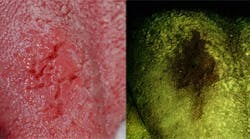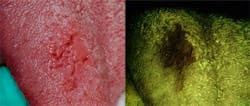Robert J. Whitman, MSE
Worldwide, oral cancer is a top-10 cancer.1 There are more than 274,000 cases each year, and five-year survival rates are less than 30%.1 Here in the United States, oral cancer is the only cancer that has increased in prevalence each of the past eight years.2 There will be an estimated 51,540 cases in 2018,2 and due to new risk factors such as human papillomavirus (HPV), the survival rate of oral cancer has remained at about 50%.3 These are just a few of the reasons you should reevaluate the way you look at oral cancer screening technology in your dental practice (figure 1).
But just like any technology, you need to review the business considerations for oral cancer screening investments. The three main points to consider are as follows:
- Financial—Will it generate revenue?
- Clinical—Does it work?
- Marketing—Will it help me gain an edge on my competitors?
Let’s review these points individually.
Financial considerations
Most people who enter the dental profession have checked the “for profit” box, intending to make money while practicing dentistry. Because this is true, it becomes one of the most important factors in selecting a product or technology. Clinicians want to provide the highest standard of care for their patients, but there must be a return on investment.
Incorporating an oral cancer screening device can do just that. Adjunctive oral cancer screening devices are sometimes covered by dental insurance plans under code D0431, but there are other ways to generate revenue. Many offices now provide advanced oral cancer screenings through their hygiene departments as a fee-for-service offering. Once patients are educated about the changing trends in oral cancer and the fact that everyone is at risk, patients are more likely to accept a nominal fee for advanced screening. (See “Oral cancer screening: To charge or not to charge” in July 2015 Dental Economics.)
Squamous cell carcinoma under fluorescence light (OralID)
Clinical considerations
Oral cancer diagnoses have continued to rise over the past eight years.4 Unfortunately, late-stage oral cancer survival rates are less than 50%.2 These statistics suggest a new protocol in dentistry is needed for early discovery. Fluorescence screening technology is now available—and has been for a decade. Fluorescence is a simple, light-based technology that is being used at the nation’s top cancer centers. It is proven to help identify lesions at much earlier stages than the naked eye, thus saving lives. So, when evaluating if a product works, it is safe to say that if the product has helped save lives, it is worth incorporating into every office.
Marketing considerations
The final (and often forgotten) part of evaluating technology is its role in marketing. All dental offices should be looking for ways to differentiate themselves from their competitors, including both private and group practices. Oral cancer screenings are a proven offering that uniquely position dental offices in the eyes of patients. Whether offices are looking to attract new patients, reengage inactive patients, or fully engage current patients, the simple offering of advanced oral cancer screening can provide the competitive edge that practices are looking for.
OralID oral cancer screening device
If you are looking to make money, save lives, and differentiate your practice, incorporate an advanced oral cancer screening program to do so.
Author’s note: Learn more about life-saving technology for oral cancer and the ID For Life screening program at forwardscience.com.
References
1. Ferlay J, Parkin DM, Pisani P. GLOBOCAN 2002: cancer incidence, mortality and prevalence worldwide. Lyon, France: International Agency for Research on Cancer; 2004.
2. American Cancer Society. Cancer Facts & Figures 2018. https://www.cancer.org/content/dam/cancer-org/research/cancer-facts-and-statistics/annual-cancer-facts-and-figures/2018/cancer-facts-and-figures-2018.pdf. Published 2018.
3. Oral Cancer Facts. Oral Cancer Foundation Website. https://oralcancerfoundation.org/facts/. Accessed July 20, 2018.
4. Cronin K, Lake A, et. al. Annual Report to the Nation on the Status of Cancer, part 1: National cancer statistics. Cancer. 2018;124(13):2785-2800. https://doi.org/10.1002/cncr.31551.
Robert J. Whitman, MSE, holds a master’s degree in biomedical engineering. He began his career at MD Anderson Cancer Center, where he developed a passion for early cancer diagnostics. He is the cofounder and CEO of Forward Science, a biotechnology company established with the goal of advancing oral health care through early discovery, diagnostics, and treatment options. Forward Science has commercially available products focusing on cancer, including an oral cancer screening product, OralID, and a dry mouth/mucositis treatment, SalivaMax. Whitman speaks on oral cancer and early discovery. Contact him at [email protected].
Figure 1: Current oral cancer statistics2
Worldwide impact
- Top-10 cancer
- More than 274,000 cases annually
- Approximately 127,000 deaths/yr.
- Five-year survival rate less than 30%
United States impact
- 51,540 cases projected for 2018
- Incidence rate has increased each of past eight years (only cancer to do so)
- Five-year survival rate 50% (no significant change over past three decades)
- Young and old at risk due to new risk factors, including HPV








